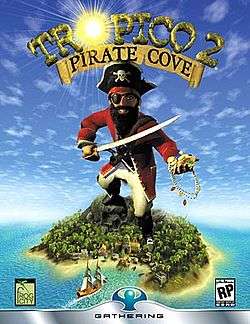Tropico 2: Pirate Cove
| Tropico 2: Pirate Cove - Joseph Legge Edition | |
|---|---|
 Tropico 2: Pirate Cove box art | |
| Developer(s) | Frog City Software |
| Publisher(s) | Gathering of Developers/Take-Two Interactive (Windows), |
| Producer(s) | Chris Lacey |
| Designer(s) | Bill Spieth/Frog City Software |
| Composer(s) | Daniel Indart |
| Series | Tropico |
| Engine | S3D |
| Platform(s) | Windows, Mac OS X |
| Release date(s) |
|
| Genre(s) | Construction and management simulation |
| Mode(s) | Single player |
Tropico 2: Pirate Cove is the 2003 sequel to the computer game Tropico. Tropico 2 was developed by Frog City Software and published by Gathering of Developers for Windows and Mac OS X PCs.
Gameplay
Though much of it is based on the original Tropico, the gameplay is very different. The player runs a pirate island and, as the Pirate King, must keep the pirates happy while stealing as much booty as possible. Workers, called captives, are taken on raids, from shipwrecks off the player's island, or from nations with which an alliance has been established. They are the lifeblood of the economy, and all constructions and productions are done by their hands. They can take on most of the jobs available, including farmer, lumberjack, and blacksmith, and can even be promoted to a pirate. Skilled captives may be able to perform more specialized jobs which unskilled captives cannot. Still, the main goal of the game, other than the objectives stated in a scenario, is to stay in power, much like the original Tropico.
To keep captives happy, order must be instilled on the island, along with providing them food in the form of slop from chuck tents and a chance to pray at church (requires at least one Skilled priest on the island). Pirates, however, prefer anarchy and defense, along with grub, grog, wenches, and betting from various entertainment buildings as well as resting and stashing at personal homes. Anarchy is the opposite of order so the more anarchy there is in an area, the less order and vice versa. You also need to keep the captives afraid in the form of structures that emanate a sense of fear, so they live in fear of you, and will not run away or escape the island. This is important because some escaping captives inform angry monarchs of your island location, and angry monarchs may send warships your way, while other escaping captives may decide to lead a captive uprising to oust you from your Palace. Pirate ships may be built at boatyards or shipyards, and are used to plunder other islands or board enemy ships to steal gold with which you can build a greater pirate base and occasionally wealthy captives, who do not work but have a ransom that increases as they use entertainment buildings. There are also several challenging scenarios in which the goal is to survive in harsh environments, from angry pirates to escaping captives.
On the whole, the game is more streamlined than the original Tropico. There are fewer building areas the player needs to worry about and the importance of the political factions is marginalized to the point of rendering them meaningless. The "reverse economy" requires less production because money can be stolen to satisfy certain objectives. However, money cannot be plundered if the following production list is not followed.
- A dock must exist (most scenarios start with one but it can be demolished if told to)
- A pirate ship must exist (most scenarios start with one; but if it is sunk or scuttled, a boatyard(minimum) is necessary which requires that a shipwright must have been kidnapped to build a replacement, though sometimes you start with one,(as shipwrights do not wash ashore like regular captives))
- The pirate ship must have(at minimum) cutlasses for weapons (requires iron mine, blast furnace, and a blacksmith(minimum))
- The pirate ship must have sea rations for the pirates to eat while at sea (requires sea ration factory and corn farm)
- Numbers 3 or 4 may be bypassed only if a black market has been constructed and sufficient money to outfit the ship is available for either missing sea rations or missing cutlasses or both
- All buildings in numbers 1-4 require lumber for their construction (requires timber yard and saw mill; lumber is one of the most important resources in the game)
- Any construction of buildings requires a construction tent and the workers that fill the positions
- All production buildings, raw materials buildings and black market (numbers 2-6) require captives to fill the positions because the pirates do not do any of those kinds of jobs. However, some buildings allow for pirates to be hired as overseers to keep the captives in line.
At last, the game offers fewer choices for development. In Tropico, the economy could be focused on industry, tourism, military despotism, commodities, or a combination of all four. In Pirate Cove, the player is more limited in scope and path, and will end up building many of the same buildings every time with few additions, which means Pirate Cove does not have the emphasis on spreadsheets and statistics that its predecessor did.
Tropico 2 is the first game to have a campaign in the series, in which each scenario has a goal to be accomplished within the time limit. Goals can range from constructing certain structures, having enough money in the treasury or personal stash, ensuring overall pirate happiness is above a certain point, achieving harmonious relations with a faction, and having a certain number of ships on the island. The campaign follows a pirate king whose traits change as the campaign goes on. It is generally recommended for players to play the first few missions of the campaign before playing harder predefined scenarios.